Karl Emanuel Martin Weber, known as “Kem,” was a German furniture and industrial designer, architect, art director and teacher, who pioneered the Streamline style.
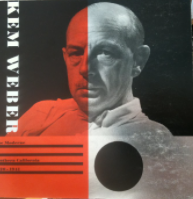
Image source: https://search.creativecommons.org/photos/dde7ad37-3e24-4e2e-84fa-e070a9405855 by pheezy
Early Life
Born in Berlin, Germany, Karl Emanuel Martin Weber began his tutelage, at the local Kunstgewerbeschule, under the architect Bruno Paul. His teacher guided him through the design and supervision of the German Pavilion’s construction, at the 1910 International Exposition in Brussels. By 1912, he graduated, and started work in Paul’s very own studio.
However, his career leads him away from Germany, and to a brand-new horizon. Thus, he constructed the second pavilion as an unexpected turning point, and as a consequence Paul would decide to send him to San Francisco, to supervise on the German pavilion being built for the Panama-Pacific International Exposition of 1915. However, the onset of World War I prevented him from returning to Germany, and with the suspension of the pavilion’s construction, he was stranded in California.
Working through the War
Suffering from the anti-German sentiment of the time, he retired for a few years. Finally, in 1921, the Barker Brothers noticed his work and impressed by his talent, made him their Art Director. Having received full-fledged American citizenship in 1924, Weber, through the 1920s, designed several lines of modern furniture. After changing his name to”Kem,” which was a combination of his initials, he introduced European Modernism to the company. Then, after much convincing, in the 1926 opening of the new Modes and Manners shop, whose jagged shapes, startling colors, and frenzied patterns made it stand out like nothing before.
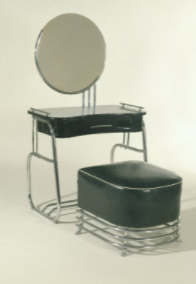
Image source: https://en.wikipedia.org/wiki/Kem_Weber#/media/File:Kem_Weber.Vanity_with_Mirror,_1934.jpg
Weber curated every detail of the new shop, from the wall treatments to the display cases. Further, the shop offered a vast assortment of products, furniture and lamps, an extensive textile department, silver and metal accessories, and even a dining room for guests, all with the lastest and most chic furnishings. Therefore, one could buy something as small as an ashtray or as large as an entire custom-designed interior set.
In 1927, after feeling held back by the company’s approach, he left Barker Brothers and opened his design studio in Los Angeles. Thus, establishing himself as an independent Hollywood firm, often working on movie sets and private residences.
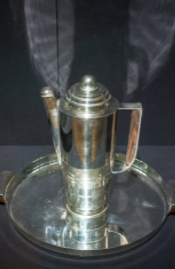
image source: https://search.creativecommons.org/photos/f4a5c42a-2bd0-4aae-a2b8-a9796f11b2bf by Tim Evanson
Weber designed furniture for Higgins Mfg.Co., Meyers Co., Berkley and Gay, Karpen Furniture Co., Noha Furniture Co., Grand Rapids Furniture Co., and Lloyd Mfg. Co. Additionally, he designed a line of modern clocks for the Lawson Clock Co.
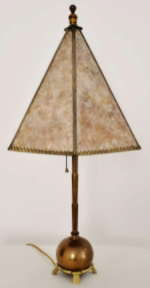
image source: https://www.1stdibs.com/furniture/lighting/table-lamps/american-art-deco-brass-table-lamp-mica-shade/id-f_910129/
Weber Experiments
Weber was especially eager to explore the possibilities offered by new materials and production methods, from tubular metal to the new man-made materials that were beginning to appear in the marketplace. Also, he had interest in investigating new approaches for constructing furniture, moving away from traditional forms of joinery and support. He worked on an idea, “Bentlock” furniture, which relied on bent hardwood. The technique produced a distinctive and novel cast for his pieces, but as it proved impractical, he eventually abandoned it.
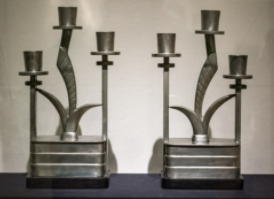
Image source: https://search.creativecommons.org/photos/bc6f620a-ec6f-4be2-be4b-45f8f627fa46 by Tim Evanson
Weber’s production was halted by World War II’s, and his attempts to interest the government in a defense-oriented construction system for housing projects fell flat. After the war, he moved back to Santa Barbara, where he kept working as a house architect. There, he died in 1963.
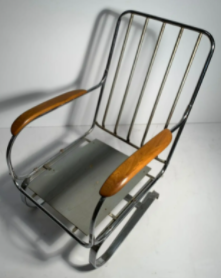
Image source: https://www.1stdibs.com/furniture/seating/lounge-chairs/kem-weber-deco-chrome-springer-chair/id-f_24306902/
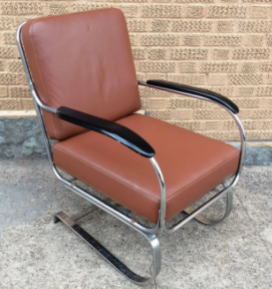
Image source: https://www.1stdibs.com/furniture/seating/armchairs/machine-age-kem-weber-lloyd-chrome-leather-lounge-chair/id-f_5704923/
Features of Weber’s Style
Many of his designs are in his “Streamline Moderne,”which was popular in contemporary architecture, as well as in the industrial designs of his contemporaries such as Raymond Loewy.
Airline Chair (1934) was his most famous work and was an early form of furniture meant to be sold to the consumer in separate parts. Thus, the final assembly was left to the user at home. Also, the piece exemplified the clean, streamlined style of the age, but unfortunately for living rooms everywhere, the design did not catch on. Moreover, only about 200 were ever produced. Additionally, California’s Walt Disney Studios office complex purchased many of the limited 1934 production.
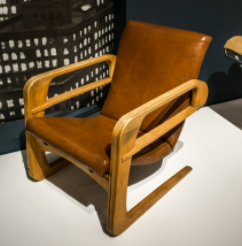
Image source: https://search.creativecommons.org/photos/772f0d8e-bede-4ce5-ad8a-dce8c3b01782 by Tim Evanson
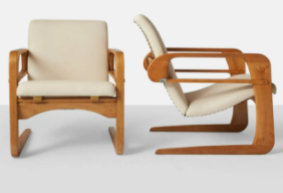
Image source:https://www.1stdibs.com/furniture/seating/club-chairs/pair-of-kem-weber-airline-chairs/id-f_9546563/
Info sources:
https://en.wikipedia.org/wiki/Kem_Weber
http://www.themagazineantiques.com/article/kem-weber-southern-california/
